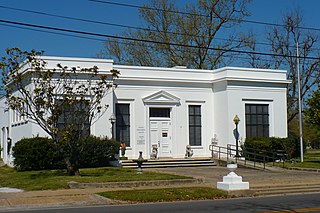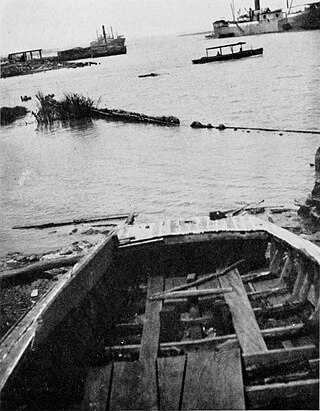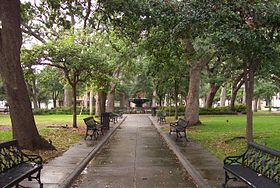
Mobile is a city and the county seat of Mobile County, Alabama, United States. The population within the city limits was 187,041 at the 2020 census, down from 195,111 at the 2010 census. After a successful vote to annex areas west of the city limits in July 2023, Mobile's population increased to 204,689 residents. It is now the second-most-populous city in Alabama, after Huntsville.

Mobile Bay is a shallow inlet of the Gulf of Mexico, lying within the state of Alabama in the United States. Its mouth is formed by the Fort Morgan Peninsula on the eastern side and Dauphin Island, a barrier island on the western side. The Mobile River and Tensaw River empty into the northern end of the bay, making it an estuary. Several smaller rivers also empty into the bay: Dog River, Deer River, and Fowl River on the western side of the bay, and Fish River on the eastern side. Mobile Bay is the fourth largest estuary in the United States with a discharge of 62,000 cubic feet (1,800 m3) of water per second. Annually, and often several times during the summer months, the fish and crustaceans will swarm the shallow coastline and shore of the bay. This event, appropriately named a jubilee, draws a large crowd because of the abundance of fresh, easily caught seafood.

Jean-Baptiste Le Moyne de Bienville, also known as Sieur de Bienville, was a French-Canadian colonial administrator in New France. Born in Montreal, he was an early governor of French Louisiana, appointed four separate times during 1701–1743. He was the younger brother of explorer Pierre Le Moyne d'Iberville.

The Bankhead Tunnel, formally the John H. Bankhead Tunnel, is a road tunnel in Mobile, Alabama that carries Government Street under the Mobile River from Blakeley Island to the downtown Mobile business district. It is named for John H. Bankhead, an Alabama politician and U.S. Senator who was also the grandfather of actress Tallulah Bankhead. It, like the larger George Wallace Tunnel a few blocks downriver from it, was constructed in Mobile at the shipyards of the Alabama Drydock and Shipbuilding Company (ADDSCO), from 1938-1940. The eastern end of the Bankhead Tunnel features a large "flood door" that can be closed to prevent water from Mobile Bay flooding the tunnel during surges from hurricanes or tropical storms. It was added to the Alabama Register of Landmarks and Heritage on January 25, 1977.

Mobile, Alabama during the American Civil War was an important port city on the Gulf of Mexico for the Confederate States of America. Mobile fell to the Union Army late in the war following successful attacks on the defenses of Mobile Bay by the Union Navy.

The Old Mobile Site was the location of the French settlement La Mobile and the associated Fort Louis de La Louisiane, in the French colony of New France in North America, from 1702 until 1712. The site is located in Le Moyne, Alabama, on the Mobile River in the Mobile-Tensaw River Delta. The settlement served as the capital of French Louisiana from 1702 until 1711, when the capital was relocated to the site of present-day Mobile, Alabama. The settlement was founded and originally governed by Pierre Le Moyne d'Iberville. Upon the death of d'Iberville, the settlement was governed by his younger brother, Jean-Baptiste Le Moyne de Bienville. The site can be considered a French counterpart to the English colonial settlement at Jamestown, Virginia. The settlement site and fort were listed on the National Register of Historic Places on May 6, 1976. The Old Mobile Site was determined eligible for designation as a National Historic Landmark on January 3, 2001.

Fort Charlotte, Mobile is a partially-reconstructed 18th-century fort in Mobile, Alabama.

Brookley Air Force Base is a former United States Air Force base located in Mobile, Alabama. After it closed in 1969, it became what is now known as the Mobile Aeroplex at Brookley.

Mobile was founded as the capital of colonial French Louisiana in 1702 and remained a part of New France for over 60 years. During 1720, when France warred with Spain, Mobile was on the battlefront, so the capital moved west to Biloxi. In 1763, Britain took control of the colony following their victory in the Seven Years' War. During the American Revolutionary War, the Spanish captured Mobile and retained it by the terms of the Treaty of Paris in 1783.

Cudjoe Kazoola Lewis, born Oluale Kossola, and also known as Cudjo Lewis, was the third to last adult survivor of the Atlantic slave trade between Africa and the United States. Together with 115 other African captives, he was brought to the United States on board the ship Clotilda in 1860. The captives were landed in backwaters of the Mobile River near Mobile, Alabama, and hidden from authorities. The ship was scuttled to evade discovery, and remained undiscovered until May 2019.

The National African American Archives and Museum, formerly known as the Davis Avenue Branch of Mobile Public Library, is an archive and history museum located in Mobile, Alabama. It serves as a repository for documents, records, photographs, books, African carvings, furniture, and special collections that relate to the African-American experience in the United States. Some of the collection was developed when the building was part of the Mobile Public Library as the Davis Avenue Branch.

The Mobile Public Library is a public library system primarily serving Mobile County, Alabama. The system is a department of the city of Mobile and receives funding from Mobile County and the city of Saraland.

The schooner Clotilda was the last known U.S. slave ship to bring captives from Africa to the United States, arriving at Mobile Bay, in autumn 1859 or on July 9, 1860, with 110 African men, women, and children. The ship was a two-masted schooner, 86 feet (26 m) long with a beam of 23 ft (7.0 m).

Africatown, also known as AfricaTown USA and Plateau, is a historic community located three miles (5 km) north of downtown Mobile, Alabama. It was formed by a group of 32 West Africans, who in 1860 were bought and transported against their will in the last known illegal shipment of slaves to the United States. The Atlantic slave trade had been banned since 1808, but 110 slaves held by the Kingdom of Dahomey were smuggled into Mobile on the Clotilda, which was burned and scuttled to try to conceal its illicit cargo. More than 30 of these people, believed to be ethnic Yoruba, Ewe, and Fon, founded and created their own community in what became Africatown. They retained their West African customs and language into the 1950s, while their children and some elders also learned English. Cudjo Kazoola Lewis, a founder of Africatown, lived until 1935 and was long thought to be the last survivor of the slaves from the Clotilda living in Africatown.

The Mobile–Tensaw River Delta is the largest river delta and wetland in Alabama. It encompasses approximately 260,000 acres (110,000 ha) in a 40-by-10-mile area and is the second largest delta in the contiguous United States. This large river delta is approximately 45 miles long and averages 8 miles wide, being 16 miles wide at its widest point. It covers approximately 300 square miles. Of its 260,000 acres, 20,000 acres consist of open water, 10,000 acres of marsh, 70,000 acres of swamp; and more than 85,000 acres of bottomland forest. It drains an area of about 44,000 sq miles, which includes 64% of Alabama and small portions of Georgia and Mississippi.

This is a list of the National Register of Historic Places listings in Mobile, Alabama.

The Protestant Children's Home, also known as the Protestant Orphans' Asylum, is a historic orphanage building in Mobile, Alabama, United States. It was placed on the National Register of Historic Places on June 18, 1973.
In 2015 the building was leased to the Infant Mystics society which began using it as a meeting lodge, renaming the place Cotton Hall.
The Historic Roman Catholic Properties in Mobile Multiple Property Submission is a multiple property submission of Roman Catholic properties in Mobile, Alabama, that were listed together on the National Register of Historic Places. The submission covers cemetery, church, convent and other religious properties that are historically or architecturally significant.
Timothy Meaher was the son of an Irish immigrant father and an Anglo-Irish American mother. He was raised in rural Whitefield, Maine. In his 20s, he moved to Mobile, Alabama where he became a wealthy human trafficker, businessman and landowner. He built and owned the slave-ship Clotilda and was responsible for illegally smuggling the last enslaved Africans into the United States in 1860.
Africatown Heritage House is a community building in Mobile, Alabama that houses "Clotilda: The Exhibition" about the survivors and descendants of slaves transported on the Clotilda, the United States' last known slave ship, many of whom established Africatown.



















